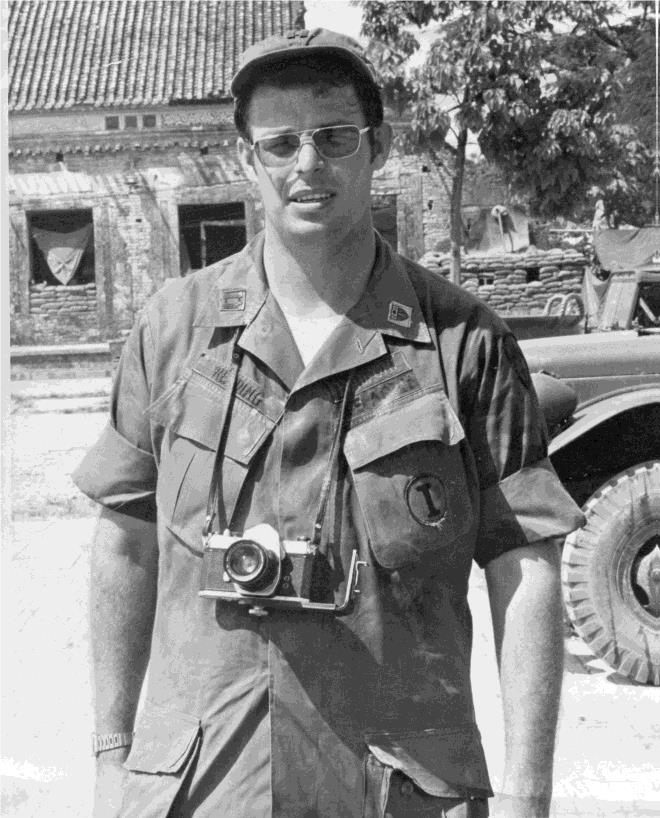
G A Redding, LTC US Army, Retired
Combat Photographer
Public Information Officer
Visual Information Pioneer
Upon graduation from DINFOS, Capt. Redding deployed to the Military Assistance Command – Vietnam (MACV) in DaNang as a Public Information Officer and MACV accredited Armed Forces Combat Photographer. Responsibilities also included escorting media during the most volatile days of the draw down of U.S. forces. Very Dangerous. One week in August, GA oversaw recovery of five reporters KIA north of Hue.
He provided daily briefings to U.S. and international media, arranged transportation, and regularly accompanied them to firebases from My Lai to the DMZ. Most notably, he photographed the 3rd Battalion 21st Infantry’s departure from hilltop 260, last time the U.S. flag was lowered at a firebase, August 11, 1972. In leaving that event, stepping on the helo’s skid, he was the last soldier to leave a U.S.firebase in Vietnam.
GA also provided local logistic support to the Department of the Army Special Photographic Operations (DASPO) and the 221st Signal Company (Pictorial) in addition to photographing local U.S. troop activities and ceremonies, VIP visits, USO shows, etc. recorded in his 333-day handwritten (in ink) Vietnam Journal.
His next PIO assignment in 1975 was Chief, Instructor Division, Broadcast Department, DINFOS, overseeing activities in the writing, radio, and television sections, and to some extent the Navy’s Shipboard Information & Training, and Education (SITE) training.
In 1979, GA was assigned to the American forces Information Service (AFIS) as Executive Assistant to Director Robert Cranston. Responsibilities included drafting and coordinating DoD policy for the Armed Forces Radio and Television Service (AFRTS); programming, validating, and as comptroller, executing the AFIS budget. Other responsibilities included all personnel staffing, hiring, and position assignments for HQ, AFIS.
GA was deeply involved in designing and establishing the AFRTS Satellite Network (AFRTS-SATNET) preparing documentation for the house Appropriations Committee. Launching this first international ‘superstation’ implementation involved securing approvals from IntelSat and ComSat, a feat that had never before been accomplished…by anyone! In 1981 he installed OSD’s first desktop video conferencing system (analog dial-up phone lines) connecting AFIS with OASD(PA) Pentagon offices.
In 1982, MAJ Redding was selected by the Army Chief, Public Affairs to serve as spokesman for U.S. forces serving in the Sinai during the Camp David Agreements implementation. He provided photo documentation for the Multinational Force & Observers (MFO) peacekeeping activities and the Egyptian flag raising ceremony formally implementing the Accords.
In 1983, at the U.S. Army Audiovisual Center, he directly influenced COMCAM operations. Responsible for the Combat Camera Detachment support at Fort Meade, he eliminated the male-only gender requirement and initiated an effort to formally install COMCAM documentation in all Joint Staff operational planning.
In March 1985, GA was ordered by SECDEF Weinberger’s office to report to AFIS. His “Special Projects Officer” task: ensure mission continuity (photo, TV, MOPIC, audio and video archives) in shuttering the Defense Audiovisual Agency (DAVA) and distributing personnel, funding, and logistic resources back to the Services. When the proposed Goldwater-Nichols Department of Defense Reorganization Act of 1975 proposed reducing the DoD’s audiovisual budget by 10%/year, and beyond, AFIS Director “Buzz” Rizer asked GA for advice. His response - for the DoD to replace “audiovisual” (a Hollywood on the Potomac hot button item) with “visual information” in all DoD documents: mission statements, staffing, funding, contracting, etc. The Comptroller OSD agreed, and so began a complete DoD-wide overhaul under the newly defined (by GA) term.
LTC Redding then served in two AFIS positions at the Defense Audiovisual Policy (DAP) office; first as Chief, Audiovisual Resources Division and later as Chief, Audiovisual Management Division. The DoD was transitioning to digital media. To protect DoD’s interests, GA transferred $200,000 to the National Institute of Standards develop CD-ROM, and to support the Joint Photographic Experts Group (JPEG) effort to achieve an industry standard acceptable to DoD’s interests. Digital photography was in its infancy and GA worked with still and video camera manufacturers to ensure DoD’s requirements could be achieved. He retired July 1990.
Bio provided by GA Redding